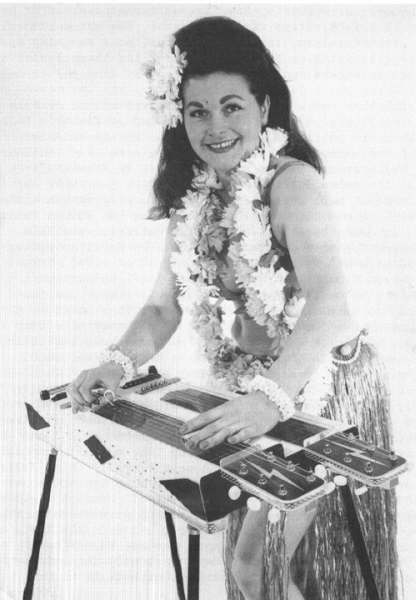Hawaiian Crash Course
(in C6th tuning)
Musical arrangements by David J.
Stewart
 I'm going to give you some of the most commonly played note progressions in
my Hawaiian music and more. If you just learn these quick tabs, you'll be
able to jump in and play along with any band. It's not hard to play Hawaiian
music on the steel guitar if you know what to play. I'm going to show you.
Half the battle in learning to play steel guitar is becoming familiar with
the sounds and that's what this page is intended to do.
I'm going to give you some of the most commonly played note progressions in
my Hawaiian music and more. If you just learn these quick tabs, you'll be
able to jump in and play along with any band. It's not hard to play Hawaiian
music on the steel guitar if you know what to play. I'm going to show you.
Half the battle in learning to play steel guitar is becoming familiar with
the sounds and that's what this page is intended to do.
These licks will work in just about any song once you find the proper song
key. When I
don't know a song's key, I just slide the bar up the guitar neck until it
sounds right. It works for me.
Here are some nice MP3 rhythm
tracks that I made with Band-in-a-Box:
Song of the Islands and
Lovely Hula Hands. They
have real instruments (from the BB 2010.5 version). You're welcome to use
them as you wish. They're both in the key of F. Here's
a bunch more rhythm tracks. The following tabs are adlib
licks that can
be used in many songs, or as fills to backup a singer.
If you commit these licks to
memory, you will be off to a promising start. These are some really great
tabs. Play along with your favorite Hawaiian song or the tracks which I've
provided and try out some of these musical gems. Hawaiian music is not a
guitar, it's a music style.
Nothing worthwhile in life comes
easy. You have to stick with it and work at it. I recommend ordering
Jerry Byrd's instruction
course available from Scotty's music in St. Louis, Missouri. It's the
most comprehensive lap steel course I know of. Also, it's important to
listen to lots of Hawaiian steel guitar so you'll become familiar with the
sounds and get them into your mind. You'll recognize sounds while your
learning and playing the steel guitar. Start with C6th (high-to-low: E - C -
A - G - E - C). This is the tuning that most players use. I use a C# on many tabs, but I don't use it as much in live
playing as I used to, because with the bottom C note I can't strum all across without it sounding
sour. The C# gets in the way. Bb is more natural and doesn't sound so off
when you accidentally hit it. Most professional Hawaiian steel guitarists
use an 8-string tuned as (from low to high: C - Bb - C - E - G - A - C - E).
Keep in mind when listening to
Jerry Byrd's recordings that he used his amazing
C Diatonic tuning more than most
people realize. It's just an extended C6th tuning! So if you are ever trying
to work out a Jerry Byrd song, and you can't seem to make it work, try the
Diatonic tuning. It has a wonderful 7th chord (similar to strings 6,7 and 9
on the E9th pedal steel).
There's no short cuts except a good
teacher. The following tabs don't have timing information, so it's really
difficult to know what the phrases are supposed to sound like. That's why I
made THIS TAB/AUDIO PAGE TO HELP YOU.
Here's a crash course in Jerry Byrd's style, a great sounding solo which I
tabbed out from the song “Haole Hula”
(This is a wealth of information). You can learn music theory all day (and
it's important that you learn how to construct chords), but when it comes
down to becoming a great player, nothing beats seeing firsthand what is
actually being played.
I am also a pedal steel fan. I
love Lloyd Green's style. I have
some great videos of Lloyd performing. I watch his knees carefully, seeing
what knee lever(s) that he moves, so I can accurately figure out exactly how
he is getting the sounds that he does. Although I can't see his feet, I
watch for the pedal rods to flex, indicating that he pressed a pedal. So
often what I THOUGHT he was playing was way off mark, but I learned from
observing. Hence, watch every video that you can find online of
Jerry Byrd playing
(or your favorite steel guitar artist). Watch
Kayton Roberts
(Little Brown Gal) and you'll learn a bunch of Hawaiian style techniques.
Learn to meticulously study steel artist's every move and technique. Watch
the pros!
Observing diligently (perceived
knowledge), and playing yourself (experiential knowledge), and plenty of
good tablature (acquired knowledge), will catapult you over the steep
learning curve much faster than you ever through possible. Search through
the Steel Guitar Forum for
helpful information. Learning to perform steel guitar has a steep learning
curve, that is, it's toughest getting started, but once you make it over
that initial hurdle, it gets much easier as you go. Most players quit before
they really give the instrument a chance, but those who love THE SOUND OF
STEEL GUITAR can't help but stick with the steel guitar or die trying. Try
to play your steel guitar for at least an hour a day if possible. And
remember, your brain processes what you've learned WHILE YOU'RE SLEEPING, so
don't get discouraged if it seems that your practice is in vain. Hit it
again tomorrow, God willing. One day you'll look back and wonder how you
ever got to where you are, performing techniques that you never thought were
possible.
Learning To Improvise
By Following The Scales
Here's what I did with “Pretty
Mermaid Of The Southern Sea” by
Johnny Pineapple (and
here's a second
version with some added muting techniques also. I'm just messing around
with the scales and chords in these recordings, not trying to play an
arrangement. I like them both, but their only purpose is to demonstrate to
you what can be done once you learn to move gracefully in and out of the
scales (I'm still learning). To mute the strings, just put your palm at the
bridge (but not on the bridge). In these recordings I'm using a CANOPUS S-8
(tuning, (low to high: C - Bb - C - E - G - A - C - E). I've tabbed a few
tricky parts where you can learn to dance in the scales (so-to-speak). There are many ways
to play it, whatever sounds good and the timing fits.
I've tabbed a few of the basic
things I'm playing, just to point you in the right direction. A “vamp” is
defined as “an improvised accompaniment.” These are some more common
Hawaiian vamps. I'm making
stuff up as I go, following the scales. Some of these are just short licks
that I piece together to form longer pieces. The goal is to try to make them
sound seamless. Also, notice that I'm picking in a kind of staccato manner,
not spending too much time on one chord. This allows you to play virtually
anything, even sour notes, but they still fit. This is a good song to
develop your timing and scales...
Listen To
MP3 Audio Clip Of Tabs Below...
E___7-8_______8___6_______________________________________________
C___7-8______________~7___________________________________________
A___7-8__________________6_________________7_____7___8____________
G___7-8____~8______________6___________6______6___________________
E___7-8___________________________5-6________________8____________
C___7-8________________________6_____________________8____________
Bb________________________________________________________________
C__Intro__________________________________________________________
Listen To MP3 Audio Clip Of Tabs Below; And Here...
E___________________________|_____________________________________
C___________________________|_____________________________________
A___________________________|______________6__5~~4_______3________
G________3___~4__3__________|____3__4~~5_______________4__________
E_____4____4________4_______|_4______________________4____________
C______________________5__3_|_____________________________________
Bb__________________________|_____________________________________
C___________________________|_____________________________________
Listen To MP3 Audio Clip Of Tabs Below (from My Yellow Ginger Lei)...
E________________________________________________________________
C___6___7__8__9__~12_____________________________________________
A___5___7__8__9__~12_____________________________________________
G________________________________________________________________
E________________________________________________________________
C________________________________________________________________
Bb_______________________________________________________________
C________________________________________________________________
play Hawaiian Steel Guitar is to listen to the older guys play, and study their playing.
Listen To MP3 Audio Clip Of Tabs Below
E__________________|______________________________________________
C____3_____________|_____________3~~2__1__________________________
A_________~4___3___|____1__2~~3______________2__3_________________
G__________________|__1___________________1_______________________
E______3___________|______________________________________________
C__________________|______________________________________________
Bb_________________|______________________________________________
C__________________|______________________________________________
Listen To MP3 Audio Clip Of Tabs Below; Also, Here and Here...
E_______________|_________________3__4____6___7___8__|_~4_3___________
C_______________|______________3_____________________|________________
A__________4~3__|_____3~4_4~3________3_______________|________~4_4~3__
G_________4~~3__|___3____________________6___7___8___|______3_________
E________4~~~3__|____________________________________|________________
C_______4~~~~3__|____________________________________|________________
Bb_____4~~~~~3__|____________________________________|________________
C____~4~~~~~~3__|____________________________________|________________
Listen To MP3 Audio Clip Of Tabs Below; Also, Here...
E____8~~6____________________3~4__4___|___________________________
C___________7~~6__________3___________|____7___7_______7__8_______
A__________________6~5~4__________3___|_____________6_____8_______
G_____________________________________|__8___7___6________8_______
E_____________________________________|___________________8_______
C_____________________________________|___________________________
Bb____________________________________|___________________________
C_____________________________________|___________________________
The songs modulates half-way through from the key of B to C, so just move all the tabs
*BELOW: I use this technique quite a bit, which really sounds nice. You are picking the
notes separately, but within a fractionth of a second of each other. You pick the first
string with your middle finger pick and then the forefinger follows after. It's a
E______________________________|_13_12_11__*11________________________________
C___________________________8__|____________*11_______________________________
A__________16~15____________8__|________________10_9_8____8___~10__9__8_______
G_________16~~15___~16__15_____|________________________8___8_________________
E________16~~~15___~16__15__8__|______________________________________________
C_______16~~~~15_______________|______________________________________________
Bb_____16~~~~~15___~16__15_____|______________________________________________
C____~16~~~~~~15_______________|______________________________________________
1 - 4 - 5 Chord
Progression
The first thing I want you to learn
is the 1-4-5 common chord progression which is inherent to music. These
numbers are often referred to in music books in Roman numerals, which are
respectively: I,IV,V. So I will use Roman numeral numbers to keep it simple.
To get to the point, ALL SONGS have a basic common structure, which follow
the 1,4,5 progression. You can name any song, simple or complicated, and it
will use these three chords as their foundation. That's the way God made
music to work.
Just as a sentence in English
grammar needs a subject and a verb at a minimum to compose a sentence (such
as, God is!); so also does a song need to have the I-IV-V chords to compose
a song. You can have any combination of these chords, but you'll use these
chords to form any song. What do I mean by the I-IV-V chord progression?
That's easy. They just refer to the 1,4,5 notes in any particular scale (in
our case, the C scale). So our I Chord is C. Our IV chord is F. And our V
chord is G. Look at the diatonic scale below...
C - D - E -
F -
G - A - B - C
Let's use “Beyond the Reef” as an
example played in the C6th tuning. The song is played in the key of F (fret
5). So now let's take a look at the scale of F to find our I-IV-V chords...
F - G - A - Bb -
C - D - E - F
So here are the I-IV-V chord positions on the lap steel fretboard for the key of F.
Learn to visualize your fret board like this for every song. This is your basic
template for any song. Notice that your IV position is always 5-frets higher than
your I position; and your V position is 7-frest higher than your I position. So every
song will fall into the template of playing 5 and 7 frets above any particular home
position. And notice that the home position is repeated one octave higher (shown below)
E_______5________10________12_____________*(17)____*home position,____
C_______5________10________12______________(17)_____that is, your_____
A____I__5____IV__10_____V__12______________(17)_____I chord position__
G_______5________10________12______________(17)_____is repeated one___
E_______5________10________12______________(17)_____octave (12 notes)_
C_______5________10________12______________(17)_____higher.___________
Now let's study “Beyond the
Reef” in the key of F. Study the following song tablature and see
what is being played on:
-
fret 5, which is our I chord,
is an F.
-
fret 10, which is our IV chord,
is Bb.
-
fret 12, which is our V chord,
is C.
You'll learn here that “Beyond
the Reef” is built around these chords. learn to visualize you neck from
the I-IV-V concept. See how everything else fits in between these chord
positions. The I-IV-V chords are the chassis upon which everything is built
in any song...
E_________5_______________________________5__________12__11__10___
C____________7___10________________4~~5______11~~12__12__11__10___
A________________10___12~~13~~12___4~~5______11~~12_______________
G___4__5_________10___12~~13~~12___4~~5___________________________
E________________10___12~~13~~12___4~~5___________________________
Bb____________________12~~13~~12__________________________________
E_______________________________5_________________________________
C___10_______12___14~~12___10___5__________6~~~9~~~12___10________
A___10__10___12___13~~12___10______________6~~~9~~~12___10________
G_______10______________________5___4__5___5~~~8~~~11________4__5_
E_______10___12___12~~12___10_______4__5__passing chord_10___4__5_
Bb________________________________________(diminished)____________
Other than a few “PASSING CHORDS”
(which are diminished and augmented chords in songs) this song follows the
I-IV-V chord pattern. Passing chords are used to connect the I-IV-V chords
(Or it may be I-V-IV inverted). Usually a Dominant 7th chord is substituted
(used) for the V chord to return to the I chord. So the song chord
progression would be I-IV-V7-I. That's why I do in the song above.
If you study my tabs above (which
I've copied and pasted below for you to see exactly what I mean) for “Beyond
the Reef,” you'll notice that I utilized the Bb note on string 6 to give me
a C7th chord. A C# on string 6 gives you an A7th chord open (no bar on the
strings); but a Bb open gives you a C7th chord on fret 12...
E________________________V7__________I____________________________
C____________________________________5____________________________
A_____________________12~~13~~12_____5____________________________
G_____________________12~~13~~12_____5____________________________
E_____________________12~~13~~12_____5____________________________
Bb____________________12~~13~~12_________________________________
I can sum up everything I just said
with this... every song on your lap steel, no matter what tuning you use,
will be built upon the 1st, 4th and 5th notes of any particular scale. That
translates over to your steel guitar as frets 0,5 and 7 for the key of C (if
C6th is your tuning). For C6th, in the key of G, then your song is going to
start on fret 9 (G chord) and also use frets 14 (IV chord) and 16 (V chord).
So just get that into your mind...
there's five frets between your I and IV chord, and then 2 more frets to
your V chord. This is critical to understanding the steel guitar. This same
basic principle applies to pedal steel as well as lap steel. I don't care
how fancy an arrangement may be, under all the passing chords and stylish
chords (9th's, 11th's, 13th's and sustained chords), there's the chassis of
the automobile (the I-IV-V system).
Think in terms of 1,4,5 (that is:
home fret, 5 frets higher, and 7 frets higher). Use this and you can figure
out an arrangement for nearly any song. Nearly all country and Hawaiian
songs are simple 3 chord songs. Jazz might prove more difficult, because
they often use extensive chord progressions. They eventually return to the
I-IV-V chord progression, but it may be difficult to follow along in a band.
Most blues bands stick to those basic 3 chords (I-IV-V). END
Nice Things To Play On C6th Steel
Guitar
Although you can use either a C# or
a Bb for a dominant 7th chord on your lowest string (6th string), I highly
recommend using a simple C note. This allows you to strum all the way across
the neck without hitting a sour note. Increasingly I'm using a C note on the
6th string (that is, the bottom bass string).
Now that I've given you the most
basic introduction to learning to play your lap steel guitar, here's a bunch
of great practical tabs to jump right into playing some awesome things that
can be used to form songs, back-up a singer or write your own compositions.
E______________________________|_____________________3____________
C__________________4__~5_______|__2____2__________4_____5_________
A____3__________3______________|____3____3_____3________5_________
G_________2__3_________________|___________~3___________5_________
E______3_______________________|________________________5_________
C______________________________|__________________________________
E___4~5______________________|____________3__4__5___5_____________
C_______5______________4__5__|_______4__5___________5__7~~6~~5____
A__________3________3________|_____5___________________7~~6~~5____
G_____________2~~3________5__|___5______________5___4_____________
E_________________________5__|____________________________________
C____________________________|____________________________________
E___10__9~~8____________________|_________________5________3______
C_____________8_________________|_______________5_______4_____5~__
A________________7__6__5__4_____|__5__4_______5_______3_______5~__
G____________________________5__|________5__4_______3_________5~__
E_______________________________|_____________________________5~__
C_______________________________|_________________________________
E__________7_________7_________7___*7__5_____5_______5________7___
C________________________________________~6~_______6____~7________
A________5_________5_________5___________________5________________
G___4__5______4__5______4__5___________________5____________7_____
E_________________________________________________________________
C#___________________________*lots of vibrato_____________________
E____*7__5______________5______9__10__9___8__7___________________
C_________~6~________6_____7___10_11__10__9__7_______6__7~~19____
A_____________5____5_______________________________5____7~~19____
G________________5_________7____________________~5______7~~19____
E__*lots of________________7____________________________7~~19____
C___vibrato______________________________________________________
E___5__12__11__10______________________|_____5~3__________________
C___5__12__11__10__12__11__10_____7~5__|__________4-2____4__5_____
A______12__11__10__12__11__10__________|______________1___________
G___5___________________________7~~~5__|__4~5_______________5_____
E__________________12__11__10___6~~~5__|____________________5_____
C______________________________________|__________________________
E______________________|__3__5__6__8__10__~12_11_10__9__8_________
C_____4___4______4__5__|__________________________________________
A______________3____5__|__________________________________________
G___5___4____3______5__|__________________________________________
E___________________5__|__3__5__6__8__10__~12_11_10__9__8_________
C______________________|__________________________________________
E__________________0~1__1___3__4__5__|__8__7~6____________________
C__2~0~2~0_______0______0____________|__________7_________________
A____________0~1________0____________|____________7__6~~5__5__4___
G__*hammer__0_______________3__4__5__|_____________________5______
E___on_______________________________|________________________3___
C____________________________________|____________________________
E_____________8~___6______5____3__________|___________6~~5_________
C___________________________________5~~___|__5_______6~~~5_________
A____5__6__7____5_________________________|__5______6~~~~5_________
G______________________~5___~3____________|__5_____6~~~~~5_________
E________________________________~5~~~~___|__5___~6~~~~~~5_________
C_________________________________________|________________________
E___5______1~~__*3__4__5__________|__5__4~~9~~8___|________________
C___5_____1~~~___3__4__5__________|__5____________|__4~5~~17_______
A________1~~~~___3__4__5 *strum___|_____4~~8~~~___|__4~5~~17_______
G___5___1~~~~~___3__4__5__across__|__5____________|__4~5~~17_______
E______1~~~~~~___3__4__5__________|_______________|__4~5~~17_______
C___________________Here's some nice endings______|________________
E___10__11_____________________|__3~~8___9___10___|________________
C___10__11__~13__11__10~~7~~3__|__3~~7___9___10___|__~12__11__10___
A___________~13__11__10~~6~~3__|__3~~5___8________|___________10___
G___10__11_____________________|_____________10___|__~12___________
E______________________________|__________________|________________
C______________________________|__________________|________________
E____________12*______________________________|_*You may also use_
C__________12_________________________________|_the same technique
A________12___________________________________|_on frets 5,7,19 &_
G______12___*chime all 5 strings with pinky,__|_24; but pick close
E____12______just barely touching the strings_|_to the pickup for_
C____________at the 12 fret.__________________|_better success____
E_________________________8______8~10______|_______6~~~~~~~____6~~~____6___5____
C____________7______7~8______8__________9__|___5_______________________6___5____
A______5~7______7__________________________|___5_______________6___7____________
G___5______________________________________|___5___5___6___7____________________
E__________________________________________|___5________________________________
C#_________________________________________|____________________________________
E____________________________________|___12___7___10___5___12____________________
C_________________7__________________|___12___7____9___5___11___12_______________
A_______5~6___7_______7~6___5________|___12___7____8___5___10___12_______________
G___5____________________________5___|__________________________12_______________
E____________________________________|__________________________12_______________
C#___________________________________|___________________________________________
E_______5___5___3___12___11___10___11___|______0___________3___3___7__11___15____
C___7___4___5___3___12___10____9___11___|__________5___8_______3___7__11___15____
A___7___3___5___2___12____9____8___10___|__3___3___5___8_______2___6__10___14____
G___7_______________12__________________|______3___5_______3_____________________
E_______________________________________|__3___3___5___8_________________________
C#______________________________________|__3___3___________3_____________________
E____~16___15___|______________________4___5___5___~9_____________________________
C____~16___15___|___4______________4___________5___~9_____________________________
A_______________|__________4___5___________4______________________________________
G____~16___14___|______4_______________________4___~9_____________________________
E_______________|_________________________________________________________________
C#______________|_________________________________________________________________
A beautiful simple
intro to “Little Lani Jo”
by Jerry Byrd…
E___________7~__5___4___2______5~_________________________4~5__5____5~~~9_________
C____5__6___________________4_________4~______________4_____________5~~~9_________
A_________________________________4_______2___4___5____________4__________________
G___________________________________________________________________4~~~9_________
E_________________________________________________________________________________
C#________________________________________________________________________________
Please notice that I use a C# below on the 6th string. It's your choice. I think most players would be
happiest with just a C note.
E__*thumbpick forward rake_|_______6__7__8________________________
C___10__10~9__10~8_________|___5_____________9___5________________
A___10__10~9__10~8__10_____|___5___5__6__7_______5________________
G___10__10~9__10~8__10_____|___5_____________9___5________________
E___10__10~9__10~8__10_____|___5___4__5__6_______5________________
C#__________________10_____|_________________9____________________
E________________________|______*pick-blocking technique is used__
C___5__7__9__10__12__10__|__12______10______9______7________5_____
A________________________|________________________________________
G________________________|________________________________________
E___5__6__8__10__12__10__|____12~~10___10-8___8~~6____6~~5________
C________________________|________________________________________
* The trick to finger-blocking is easy. You simply mute string 2 with the pick of the 3rd finger
simultaneously as your thumbpick touches string 5. So you're alternating between strings 5 and
2 in this musical piece. Strings 5 and 2 NEVER sound at the same time while finger-blocking.
E____________|________________________|____________________________
C___4~5~~17__|________________________|___5________________________
A___4~5~~17__|_____5__~7__6__5__4_____|___5_________~2__1__________
G___4~5~~17__|___5_________________5__|___5_____1_________1________
E___4~5~~17__|________________________|___5___1___1_________1______
C____________|________________________|____________________________
E__4~5__________________|_____________________|___________4~~3______
C______5__________4__5__|__9~___________4__5__|_________4~~~~~______
A_______________________|____8____5___3_______|_______4~~~~~~~______
G________5_____5________|_______5___3______5__|__5~~4~~~~~~~~~______
E__________5~6__________|__________________5__|__5~~4~~~~~~~~~______
C#______________________|_____________________|__*great in Aloha Oe_
E______3__4__5__3_____3________|______*_______|_______12__12~10_8~__
C___5_____________________5____|_____~7~__5___|_10~~12__12__________
A__________________3______5____|__________5___|___________________7_
G______3__4__5__3__3__3___5____|__5__~6~______|_____________________
E___5___________*a nice___5____|__5__~6~__5___|_____________________
C_____________dissonant chord__|______________|_____________________
*This middle piece of music is a beautiful. It's my own little chord that I made up. I've never
seen it tabbed anywhere. I guess that's because musically it's impossible, i.e., you can't get the bar
to play strings 5 and 6 true, because it's not at the tip end of the bar. The trick to make it sound really
good is to keep going and don't stop. I slide up and then back down. It's a great chord to play in my opinion.
E___3__5__6__7__8__10__12__13__15__|__10~~~~~~~__10~~__10_________
C__________________________________|___________________10___5_____
A_________5__6__7__________12______|__10~12~10______________5_____
G___3__5___________10__12______15__|_____________10~9__9____5_____
E__________________________________|________________________5_____
C______*basic scales_______________|______________________________
E________*5______*8__________10__|____0___________________________
C___________6_______9_____10_____|___~4___0_______________________
A_____________6_______9___10_____|_______~3___0___________________
G___4__5__________________10_____|___________~2___0_______________
E_________________________10_____|_______________~3_______________
C_______*diminished chords_______|________________________________
E___0___0___0________|__0_______|__0__0__0__|_____________________
C___0___0___0___0____|__0___5___|___________|_3___________________
A_______________0____|__1___5___|__4__5__7__|_____________________
G___4___2___0________|__0___5___|___________|_3__~8__4__3~2~3~4~3_
E_______________2____|__0___5___|___________|_3__~8__4__3~2~3~4~3_
C____________________|__________|___________|_____________________
E___________________|_______15~____15~14_____14~12_____12~~14_____
C___________________|____14___14________14________12_________14___
A___10__9_____10~___|_~14_______14________14________12_________15_
G_________~10____9__|_____________________________________________
E___________________|_____________________________________________
C___________________|_____________________________________________
E___3_______________________________________|___0___0___0_________
C___3___10__9__8__7___8__7___6___5___4___3__|___2___1___0_________
A___3___10__9__8__7______6_______5_______3__|___2___1___0_________
G___3____________________________________3__|_____________________
E_______9___8__7__6______5_______4_______3__|_____________________
C___________________________________________|_____________________
E_________________________________________________________________
C_________________________________________________________________
A___13_______10_______7_______4___________________________________
G___13_13____10_10____7_7_____4_4___3_____________________________
E___13_______10_______7_______4_____3_____________________________
Bb__13_______10_______7_______4________* notice Bb on 6th string__
E___3~0~3~0___________0~1___________________0__1___3__4__5________
C__________________0______0____0~2~0______0_______________________
A______________0~1__________0__________0~1_____0__________________
G___________0________________________0_____________3__4__5________
E_________________________________________________________________
C_________________________________________________________________
E_________________________10~~__10~~__10__________________________
C_________6~~9~~12~11~10______________10___~12__11__10____________
A_____5~6~~~~9~~12~11~10__10~9_____________~12__11__10____________
G___5___________________________10~9__9___________________________
E_________________________________________________________________
C_________________________________________________________________
E____5___5~~5___3_________________________________________________
C____5___5~~4______5___5~~___5___4___2~~1___0_____________________
A________5~~3__________5~6___5___3__________0_____________________
G____5__________3____________________1~~__________________________
E__________________5______________________________________________
C_________________________________________________________________
The following steel guitar tab is from Jerry Byrd's "Little Brown Gal" recording.
E________________________________5_4_3_______________5~6~5__3_____
C_____________6_5_4________5___________5___4~5~6~7____________5___
A_______4_5_________5____5___5____________________________________
G_____5________________4__________________________________________
E___5_____________________________________________________________
C_______*try to keep it flowing.__________________________________
Hopefully some of these tabs have been helpful. Try
to piece together the different phrases that you've learned. See if you can
come up with some of your own ideas and don't be afraid to be creative.
There's no set rules on how to play. Some players like big chord voicings,
like Barney Isaacs
(1924-1996), others play on just one string most of the time, like
Bud Tutmarc (1924-2006).
A beautiful technique which is
often forgotten, or not known about, is palm muting. Some guitars makers
don't know about this technique, so they build a chrome cover over the
bridge which prevents the steel player from performing palm blocking. This
technique is a must in song like The Hukilau Song, Hawaiian War
Chant, and others. You can hear me demonstrate this technique in
“The
Hukilau Song” On Lap Steel (download)
Here's a
bunch more C6th tabs to get you acquainted with this beautiful
instrument. There's no instrument like the steel guitar. For profound
simplicity, limitless challenge and lightweight... the lap steel is the way
to go! I think the lap steel and non-pedal steel are much more challenging
than pedal steel, because you have no pedals or knee levers to rely on to
alter your chords.
Certainly pedal steel has its
place, but after playing pedal steel for a couple decades, I can truly
appreciate the great musicians of years past, like
Jerry Byrd (1920-2005), who did
wonders without using any pedals. Jerry Byrd was never against using pedals
on a steel guitar, he just didn't like the way most players used them. Jerry
states:
"I have never said that I
dislike the use of pedals - I dislike what they do with them with only a
very few exceptions."
Jerry Byrd further states:
"Regardless of how many gadgets
they invent, it all comes down to this: 'Excellency' does not come
easily and is not dependent upon 'tools' - or even whether you have two
hands and ten fingers."
Whereas a pedal and knee can be adjusted
to be perfect every time, the lap steel player must do a manual bar slant
and strive for perfection each time.
I like the lap steel because it's
simple. You've got 6-strings, no frets to deal with, and a world of
possibilities. I really enjoy muting the strings with the palm of my right
hand at the bridge, a technique not used enough by pedal steel players.
Bud Tutmarc played one
string (the song is Mapuana) better than anyone in my opinion.
Bud always played and recorded with the C#m tuning. Bud's tuning from low to
high: E, B, E, G#, C#, E). Rudi Wairata of the Kilima Hawaiians also used
this tuning. You can here Rudi here playing
Rhythm of the
Islands.
Buddy Emmons says that if you can
hum a song, you ought to be able to play it on your steel guitar too. This
means knowing a scale (i.e., do, re, me, fa, so, la, ti, do). That's the
most basic scale. If you simply learn the melody to a song, then you don't
need to know anything on this page, just play the melody, using plenty of
vibrato on your steel guitar. For sacred Gospel melodies, playing one note
is awesome; but you can play ANY song just by playing one note.
Here's a song by Johnny Kaonohi
Pineapple and His Native Islanders from the 1930's called “Palms
of Paradise.” The song is in the key of F for the first minute and then
modulates up to Ab for the rest of the song. Perhaps, try out some of these
licks in this song.
 I'm going to give you some of the most commonly played note progressions in
my Hawaiian music and more. If you just learn these quick tabs, you'll be
able to jump in and play along with any band. It's not hard to play Hawaiian
music on the steel guitar if you know what to play. I'm going to show you.
Half the battle in learning to play steel guitar is becoming familiar with
the sounds and that's what this page is intended to do.
I'm going to give you some of the most commonly played note progressions in
my Hawaiian music and more. If you just learn these quick tabs, you'll be
able to jump in and play along with any band. It's not hard to play Hawaiian
music on the steel guitar if you know what to play. I'm going to show you.
Half the battle in learning to play steel guitar is becoming familiar with
the sounds and that's what this page is intended to do. 


